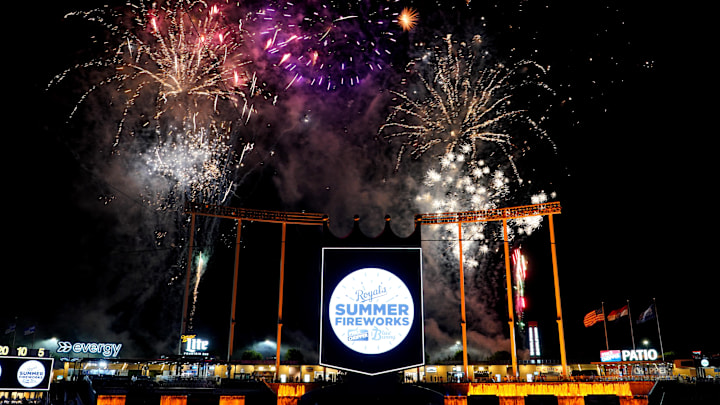Haven might be a strong word, but I am grading on a curve here. For as long as I have remembered, home runs do not happen easily in the KC Royals home, Kauffman Stadium.
Kauffman Stadium and home runs: an unlikely duo, changing this season.
According to Baseball Savant, Kauffman Stadium's home-run factor has been below average every season since 2004. In the past four seasons, Kauffman has been one of the five hardest stadiums to get past the fence. The stadium's large playing field and outfield dimensions contribute to its low home-run factor. It balances out by allowing high-contact hitters more room for singles and doubles, but even the best power hitters can struggle in Kauffman. That was seemingly the case until the 2023 season.
Baseball Savant grades park factors by hit type on a scale, with 100 being average. According to Savant's park factor leaderboard, the Royals factor jumped from 80 in 2022 to 99 in 2023. That is a big jump, raising Kauffman from the third-hardest to hit a homer in to near league average. It is a noticeable jump and the highest since 2003's 101. The Royals have hit 40 home runs at home so far this season, ranking 14th among all MLB teams in their home stadium. That is another sizeable jump. propelled by catcher Salvador Perez and shortstop Bobby Witt Jr. Even outfielder Edward Olivares, who has five total dingers this season, has four in Kauffman Stadium. His smoking shot to the scoreboard is a memorable moment, displaying his raw power from the plate. It was impressive, but even more so because fans do not see that often in Kauffman.
But here is my question: What gives? Why is this jump happening? My first thought was whether there was any difference in the ball. After all, the home-run-happy 2019 season was primarily due to differences in the ball. MLB used at least three different baseballs in 2022 alone, according to research from Meredith Wills, a Society for American Baseball Research award-winning astrophysicist. The perfect "Goldilocks balls" were found in MLB's biggest moments. Postseason games, the World Series, the All-Star Game, and when New York Yankees outfielder Aaron Judge chased history, that perfect ball was present. Thinking the MLB is tinkering with balls once again is not a crazy thought.
Another thought is the weather conditions affecting ball flight and player performance. The historical average high temperature in Kansas City, Missouri, during May is 76 degrees. But during May 2023, that average jumped to 78.3 degrees. Two degrees is not a huge shift, but any extra heat helps a baseball fly. Baseball Prsopectus' Alan M. Nathan said "a 10 degree [Fahrenheit] change in temperature is worth about a little over three feet in distance." His model, built in 2012, backs up that idea. On top of that, the 66% average humidity in Kansas City in May 2023 slightly exceeded the historical average of 65%. It may not be much, but more humid climates exert less drag on a baseball flying through the air, allowing it to fly farther.
Lastly, new rules could be the culprit. The implementation of the pitch timer in baseball has resulted in pitchers needing to work at a faster pace. This increased pace may potentially lead to poorer execution, resulting in a higher number of home runs being hit. However, more research is needed to determine if the pitch timer is truly responsible for this increase in home runs.
There is another reason that I do not want to acknowledge, but it has to be said. The 2023 Royals pitching is significantly worse than the 2022 squad at preventing home runs. In 2022, that pitching corps had a 37.57 AB/HR. That came from 75 homers across 2,818 at-bats in Kauffman Stadium. The 2023 pitching staff has an AB/HR rate of 29.82. That is only .5 better than the MLB league average of 29.32. The starting rotation is even worse, posting a 25.25 AB/HR this season. Veteran Jordan Lyles horrendous start in Kansas City may be inflating that, but surrendering home runs has been a problem with most of the starters. But it is not all bad news. The Royals batters are hitting more out of Kauffman, with a 30.93 AB/HR in 2023. That is a huge improvement compared to 2022's 41.09 AB/HR. That improvement has been cancelled out by the pitching regression in that area, though.
Overall, there could be several factors improving the home-run chances at Kauffman Stadium. It is simply not something that fans are used to. We will have some final answers following an entire season to analyze how the pitch clock, individual performances, or mysterious balls may play a factor. The sad fact remains that the change does not help the Royals much in the standings or on the scoreboard.
